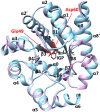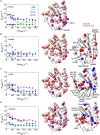Millisecond Timescale Motions Connect Amino Acid Interaction Networks in Alpha Tryptophan Synthase
- PMID: 30467546
- PMCID: PMC6236060
- DOI: 10.3389/fmolb.2018.00092
Millisecond Timescale Motions Connect Amino Acid Interaction Networks in Alpha Tryptophan Synthase
Abstract
Tryptophan synthase is a model system for understanding allosteric regulation within enzyme complexes. Amino acid interaction networks were previously delineated in the isolated alpha subunit (αTS) in the absence of the beta subunit (βTS). The amino acid interaction networks were different between the ligand-free enzyme and the enzyme actively catalyzing turnover. Previous X-ray crystallography studies indicated only minor localized changes when ligands bind αTS, and so, structural changes alone could not explain the changes to the amino acid interaction networks. We hypothesized that the network changes could instead be related to changes in conformational dynamics. As such, we conducted nuclear magnetic resonance relaxation studies on different substrate- and products-bound complexes of αTS. Specifically, we collected 15N R2 relaxation dispersion data that reports on microsecond-to-millisecond timescale motion of backbone amide groups. These experiments indicated that there are conformational exchange events throughout αTS. Substrate and product binding change specific motional pathways throughout the enzyme, and these pathways connect the previously identified network residues. These pathways reach the αTS/βTS binding interface, suggesting that the identified dynamic networks may also be important for communication with the βTS subunit.
Keywords: allostery; amino acid networks; enzyme dynamics; enzyme regulation; protein NMR; relaxation dispersion; tryptophan synthase.
Figures




Similar articles
-
Substitution of a Surface-Exposed Residue Involved in an Allosteric Network Enhances Tryptophan Synthase Function in Cells.Front Mol Biosci. 2021 May 26;8:679915. doi: 10.3389/fmolb.2021.679915. eCollection 2021. Front Mol Biosci. 2021. PMID: 34124159 Free PMC article.
-
Long-range interactions in the α subunit of tryptophan synthase help to coordinate ligand binding, catalysis, and substrate channeling.J Mol Biol. 2013 May 13;425(9):1527-45. doi: 10.1016/j.jmb.2013.01.030. Epub 2013 Jan 30. J Mol Biol. 2013. PMID: 23376097
-
Severing of a hydrogen bond disrupts amino acid networks in the catalytically active state of the alpha subunit of tryptophan synthase.Protein Sci. 2015 Apr;24(4):484-94. doi: 10.1002/pro.2598. Epub 2014 Dec 11. Protein Sci. 2015. PMID: 25377949 Free PMC article.
-
Allostery, engineering and inhibition of tryptophan synthase.Curr Opin Struct Biol. 2023 Oct;82:102657. doi: 10.1016/j.sbi.2023.102657. Epub 2023 Jul 17. Curr Opin Struct Biol. 2023. PMID: 37467527 Review.
-
Characterization of enzyme motions by solution NMR relaxation dispersion.Acc Chem Res. 2008 Feb;41(2):214-21. doi: 10.1021/ar700132n. Epub 2008 Feb 19. Acc Chem Res. 2008. PMID: 18281945 Review.
Cited by
-
Distinct conformational dynamics and allosteric networks in alpha tryptophan synthase during active catalysis.Protein Sci. 2021 Mar;30(3):543-557. doi: 10.1002/pro.4011. Epub 2020 Dec 19. Protein Sci. 2021. PMID: 33314435 Free PMC article.
-
Backbone assignments and conformational dynamics in the S. typhimurium tryptophan synthase α-subunit from solution-state NMR.J Biomol NMR. 2020 Jul;74(6-7):341-354. doi: 10.1007/s10858-020-00320-2. Epub 2020 May 15. J Biomol NMR. 2020. PMID: 32415580 Free PMC article.
-
Substitution of a Surface-Exposed Residue Involved in an Allosteric Network Enhances Tryptophan Synthase Function in Cells.Front Mol Biosci. 2021 May 26;8:679915. doi: 10.3389/fmolb.2021.679915. eCollection 2021. Front Mol Biosci. 2021. PMID: 34124159 Free PMC article.
References
-
- Axe J. M., O'Rourke K. F., Kerstetter N. E., Yezdimer E. M., Chan Y. M., Chasin A., et al. . (2015). Severing of a hydrogen bond disrupts amino acid networks in the catalytically active state of the alpha subunit of tryptophan synthase. Protein Sci. 24, 484–494. 10.1002/pro.2598 - DOI - PMC - PubMed
LinkOut - more resources
Full Text Sources
Research Materials

